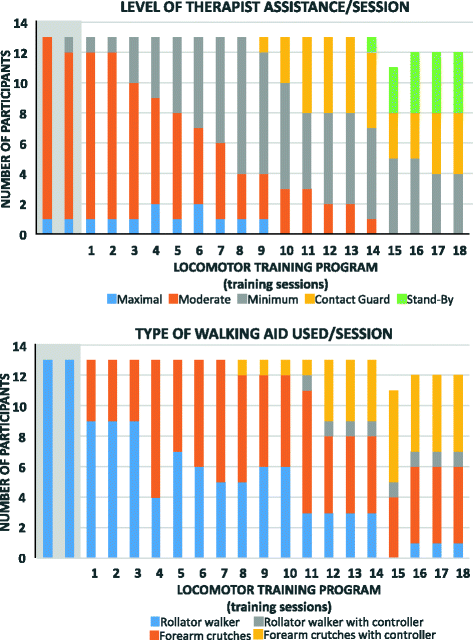Locomotor training using an overground robotic exoskeleton in long-term manual wheelchair users with a chronic spinal cord injury living in the community: Lessons learned from a feasibility study in terms of recruitment, attendance, learnability, performance and safety
- PMID: 29490678
- PMCID: PMC5831695
- DOI: 10.1186/s12984-018-0354-2
Locomotor training using an overground robotic exoskeleton in long-term manual wheelchair users with a chronic spinal cord injury living in the community: Lessons learned from a feasibility study in terms of recruitment, attendance, learnability, performance and safety
Abstract
Background: For individuals who sustain a complete motor spinal cord injury (SCI) and rely on a wheelchair as their primary mode of locomotion, overground robotic exoskeletons represent a promising solution to stand and walk again. Although overground robotic exoskeletons have gained tremendous attention over the past decade and are now being transferred from laboratories to clinical settings, their effects remain unclear given the paucity of scientific evidence and the absence of large-scale clinical trials. This study aims to examine the feasibility of a locomotor training program with an overground robotic exoskeleton in terms of recruitment, attendance, and drop-out rates as well as walking performance, learnability, and safety.
Methods: Individuals with a SCI were invited to participate in a 6 to 8-week locomotor training program with a robotic exoskeleton encompassing 18 sessions. Selected participants underwent a comprehensive screening process and completed two familiarization sessions with the robotic exoskeleton. The outcome measures were the rate of recruitment of potential participants, the rate of attendance at training sessions, the rate of drop-outs, the ability to walk with the exoskeleton, and its progression over the program as well as the adverse events.
Results: Out of 49 individuals who expressed their interest in participating in the study, only 14 initiated the program (recruitment rate = 28.6%). Of these, 13 individuals completed the program (drop-out rate = 7.1%) and attended 17.6 ± 1.1 sessions (attendance rate = 97.9%). Their greatest standing time, walking time, and number of steps taken during a session were 64.5 ± 10.2 min, 47.2 ± 11.3 min, and 1843 ± 577 steps, respectively. During the training program, these last three parameters increased by 45.3%, 102.1%, and 248.7%, respectively. At the end of the program, when walking with the exoskeleton, most participants required one therapist (85.7%), needed stand-by or contact-guard assistance (57.1%), used forearm crutches (71.4%), and reached a walking speed of 0.25 ± 0.05 m/s. Five participants reported training-related pain or stiffness in the upper extremities during the program. One participant sustained bilateral calcaneal fractures and stopped the program.
Conclusions: This study confirms that larger clinical trials investigating the effects of a locomotor training program with an overground robotic exoskeleton are feasible and relatively safe in individuals with complete motor SCI. Moreover, to optimize the recruitment rate and safety in future trials, this study now highlights the need of developing pre-training rehabilitation programs to increase passive lower extremity range of motion and standing tolerance. This study also calls for the development of clinical practice guidelines targeting fragility fracture risk assessment linked to the use of overground robotic exoskeletons.
Keywords: Exercise; Paraplegia; Physical medicine and rehabilitation; Robotics; Technology; Therapies; Walking.
Conflict of interest statement
Competing interests
The authors declare that they have no competing interests.
Publisher’s Note
Springer Nature remains neutral with regard to jurisdictional claims in published maps and institutional affiliations.
Figures
References
-
- Lajeunesse V, Vincent C, Routhier F, Careau E, Michaud F. Exoskeletons' design and usefulness evidence according to a systematic review of lower limb exoskeletons used for functional mobility by people with spinal cord injury. Disability and Rehabilitation: Assistive Technology. 2016;11:535–547. doi: 10.3109/17483107.2015.1080766. - DOI - PubMed
Publication types
MeSH terms
LinkOut - more resources
Full Text Sources
Other Literature Sources
Medical
Miscellaneous




